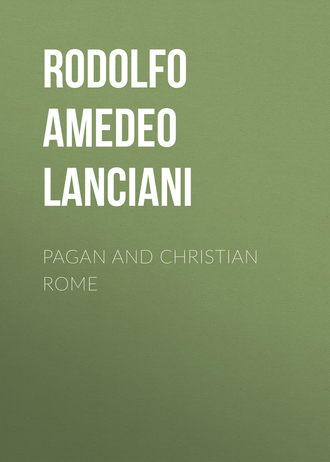 полная версия
полная версияPagan and Christian Rome
Under the protection of these alleged saints, Pomponius and his friends worshipped, and celebrated the birthday of Rome, and the goddesses connected with the city.176
This state of things did not wholly escape the attention of contemporary observers. One of them, Raffaele Volaterrano, expressly says: "Pomponius Lætus worshipped Romulus and kept the birthday of Rome; the beginning of a campaign against religion (initium abolendæ fidei)."
The Roman academy found the means of keeping faithful to its traditions, and to the spirit of its institutions, in spite of the reform of its statutes. Victor, Fortunatus, Genesius, in whose honor divine service was performed on April 20, did not represent to the initiated the saints of the Church, but the fortunes of ancient Rome, its founder, the Paliliæ. Still, we are not yet able to discover whether all this was done simply out of love and admiration for the ancient world, under the influence of the Renaissance of classical studies; or from hatred and contempt of Christian faith: initium abolendæ fidei.
THE ENDINSCRIPTION COMMEMORATING THE LUDI SÆCULARES CELEBRATED IN THE YEAR 17, B. C
TEXT AS EDITED BY MOMMSEN(See Chapter II., pp. 73-82)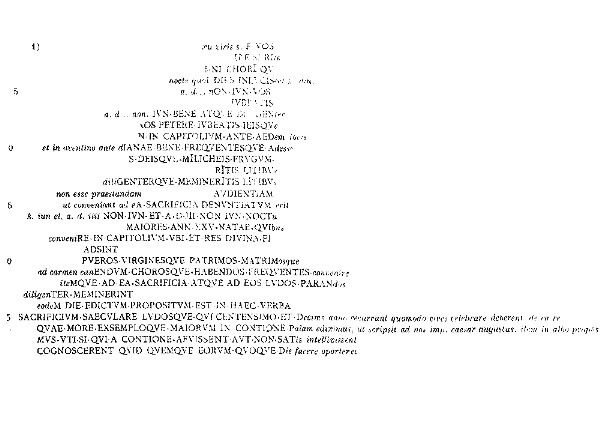
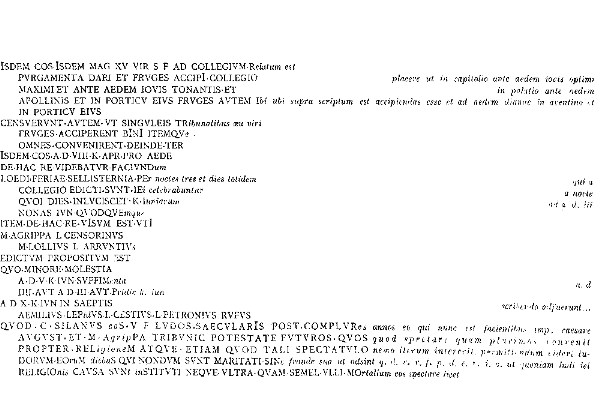
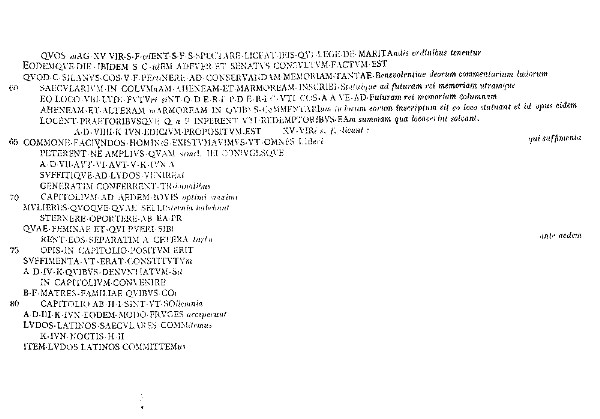

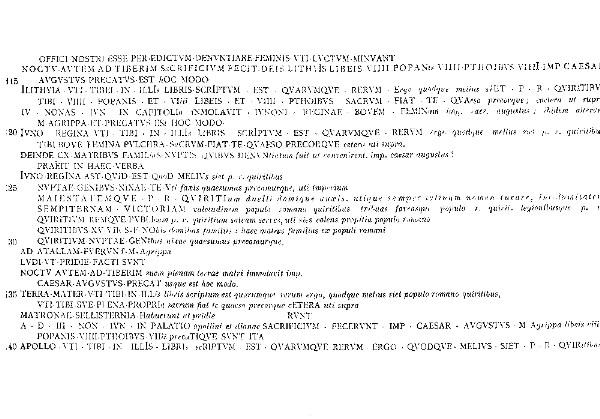
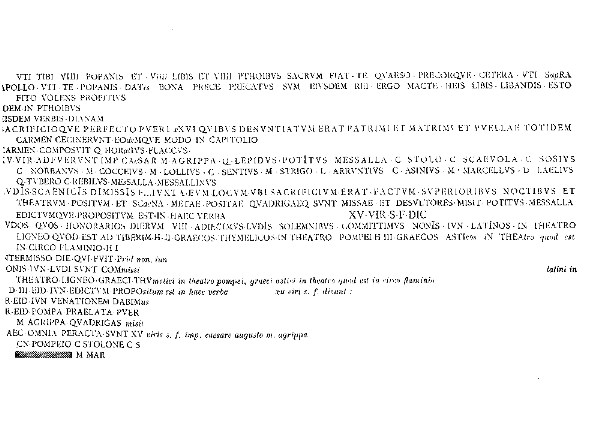
1
The relations between the Empire, the Christians, and the Jews have been discussed by really numberless writers, beginning with the Fathers of the Church. I have consulted, among the moderns: Mangold: De ecclesia primæva pro cæsaribus et magistratibus romanis preces fundente. Bonn, 1881.—Bittner: De Græcorum et Romanorum deque Judæorum et christianorum sacris jejuniis. Posen, 1846.—Weiss: Die römischen Kaiser in ihrem Verhältnisse zu Juden und Christen. Wien, 1882.—Mourant Brock: Rome, Pagan and Papal. London, Hodder & Co. 1883.—Backhouse and Taylor: History of the primitive Church. (Italian edition.) Rome, Loescher, 1890.—Greppo: Trois mémoires relatifs à l'histoire ecclésiastique.—Döllinger: Christenthum und Kirche.—Champagny (Comte de): Les Antonins, vol. i.—Gaston Boissier: La fin du paganisme, etc., 2 vols. Paris, Hachette, 1891.—Giovanni Marangoni: Delle cose gentilesche trasportate ad uso delle chiese. Roma, Pagliarini, 1744.—Mosheim: De rebus Christianis ante Constantinum.—Carlo Fea: Dissertazione sulle rovine di Roma, in Winckelmann's Storia delle arti. Roma, Pagliarini, 1783, vol. iii.—Louis Duchesne: Le liber pontificalis. Paris, Thorin, 1886-1892.—G.B. de Rossi: Bullettino di archeologia cristiana. Roma, Salviucci, 1863-1891.
2
See de Rossi: Bullettino di archeologia cristiana, 1888-1889, p. 15; 1890, p. 97.—Edmond Le Blant: Comptes rendus de l'Acad. des Inscript., 1888, p. 113.—Arthur Frothingham: American Journal of Archæology, June, 1888, p. 214.—R. Lanciani: Gli horti Aciliorum sul Pincio, in the Bullettino della commissione archeologica, 1891, p. 132; Underground Christian Rome, in the Atlantic Monthly, July, 1891.
3
See Ersilia Lovatelli: Il Monte Pincio, in the Miscellanea archeologica, p. 211.—Rodolfo Lanciani: Su gli orti degli Acili sul Pincio, in the Bullettino di corrispondenza archeologica, 1868, p. 132.
4
A description of the beautiful villa of Herodes, adjoining the Catacombs of Prætextatus, will be found in chapter vi. pp. 287 sqq.
5
A consul suffectus was one elected as a substitute in case of the death or retirement of one of the regular consuls.
6
Lampridius, in Sev. Alex., c. 43.
7
In chapter v., p. 122, of Ancient Rome, I have attributed these graffiti to the second half of the first century; but after a careful examination of the structure of the wall, on the plaster of which they are scratched, I am convinced that they must have been written towards the end of the second century.
8
Orelli, 4024, Digest L., iv. 18, 7.
9
See Ulpian: De officio Procons., i. 3.
10
Lampridius, Heliog., 3.
11
See Greppo: Mémoire sur les laraires de l'empereur Alexandre Sevère.
12
The name of the villa was Cassiacum; its memory has lasted to the present age. See the memoir of Luigi Biraghi, S. Agostino a Cassago di Brianza. Milano, 1854.
13
See Bullettino di archeologia cristiana, 1865, p. 50.
14
It contains the words PETRO LILLVTI PAVLO. They are surely genuine and ancient. I examined them in company with Mommsen, Jordan, and de Rossi, and they attributed them to the beginning of the third century of our era. The best suggestion regarding their origin is that they belong to a person, probably Christian, who used the name Petrus as gentilitium, and Paulus as cognomen, and who was the son of Lillutus, however barbaric this last name may sound.
15
See de Rossi: Bullettino di archeologia cristiana, 1863, p. 49.—Rohault de Fleury: L'arc de triomphe de Constantin, in the Révue archéologique, Sept. 1863, p. 250.—W. Henzen: Bullettino dell' Instituto, 1863, p. 183.
16
See Bibliography, p. 1. The title of the book may be translated thus: On the pagan and profane objects transferred to churches for their use and adornment.
17
The two busts of S. Peter and S. Paul, described in Cancellieri's book, Memorie storiche delle sacre teste dei santi apostoli Pietro e Paolo, Roma, Ferretti, 1852 (second edition), were stolen by the French revolutionists in 1799.
18
See Corpus Inscriptionum Latinarum, part VI., No. 351.
19
In the Byzantine period this church and the adjoining monastery were called casa Barbara patricia. They are now comprised within the cloisters of S. Antonio all' Esquilino, on the left side of S. Maria Maggiore.
20
These incrustations, and the basilica to which they belong, have been illustrated by Ciampini: Vetera monumenta, vol. i. plates xxii.-xxiv.—D'Agincourt: Histoire de l'art, Peinture, pl. xiii. 3.—Minutoli: Ueber die Anfertigung und die Nutzanwendung der färbigen Gläser bei den Alten, pl. iv.—De Rossi: La basilica di Giunio Basso, in the Bullettino di archeologia cristiana, 1871, p. 46.
21
See Andrea Amoroso: Le basiliche cristiane di Parenzo. Parenzo, Coana, 1891.—Mommsen: Corpus Inscriptionum Latinarum, vol. v. part i. nos. 365-367.
22
See Lovatelli: I labirinti e il loro simbolismo nell' età di mezzo, in the Nuova Antologia, 16 Agosto, 1890.—Arné: Carrelages émaillés du moyen âge.—Eugène Müntz: Etudes iconographiques et archéologiques sur le moyen âge.
23
See Pietro Pericoli: Lo spedale di S. Maria della Consolazione. Imola Galeati, p. 64.
24
Published in two volumes with the title: Indicazione delle immagini di Maria, collocate sulle mura esterne di Roma. Ferretti, 1853.
25
The inscription, after all, was very mild in comparison with the violent formula imposed upon Alexander VII. It read: "In memory of the absolution given by Clement VIII. to Henry IV. of France and Navarre, September 17, 1595."
26
The amphora corresponds to 26.26 litres; the metreta to 39.39 litres; the modius to 8.75 litres. The pound, divided into twelve ounces, corresponds to 327.45 grammes, a little more than 11-1/2 English ounces.
27
See Antichi pesi inscritti del museo capitolino, in the Bullettino della commissione archeologica comunale di Roma, 1884, p. 61, pls. vi., vii.
28
See de Rossi: Bullettino di archeologia cristiana, 1864, p. 57.
29
See Acta purgationis Cæciliani, post Optati opp. ed Dupin, p. 168.
30
Confess. vi. 2.
31
See Gaetano Marini: Iscrizioni doliari, p. 114, n. 279.—Giuseppe Gatti: La lex horreorum, in the Bullettino della commissione archeologica comunale di Roma, 1885, p. 110.
32
The place was called in tribus fatis, from the three statues of sibyls described by Pliny, H.N. xxxiv. See Goth. i. 25.
33
"Sank into the great flower, that is adorned
With leaves so many, and thence reascended
To where its love abideth evermore."
Longfellow's Translation.34
On the almanacs (Notitia, Curiosum), containing catalogues and statistics of Roman buildings in the fourth century, see Mommsen: Chronograph von 354, etc., in the Abhandlungen der Sächsischen Gesellschaft der Wissenschaften, vols. ii. 549; iii. 269; viii. 694.—Preller: Die Regionen der Stadt Rom. Jena: Hochhausen, 1846.—Jordan: Topographie der Stadt Rom. Berlin: Weidmann, ii., pp. 1 & 178.—Richter: Topographie der Stadt Rom, 1889, p. 5; id.: Hermes, xx., p. 91.—De Rossi: Piante iconografiche e prospettiche di Roma anteriori al sec. XVI. Roma: Salviucci, 1879.—Guido: Il testo siriaco della descrizione di Roma, etc., in the Bullettino Comunale, 1884, p. 218; and 1891, p. 61.—Lanciani: Ricerche sulle XIV regioni urbane; in the Bullettino comunale, 1890, p. 115.
35
Inscript. 139, i.
36
The fac-simile here presented is from the Corpus Inscriptionum Latinarum, vi. 820.
37
The sale of skins of victims sacrificed at Athens in the year 334 b. c., in state sacrifices only, brought a revenue of 5,500 drachmas.
38
See Henzen, Bullettino dell' Instituto, 1863, p. 58.—Mommsen: Corpus Inscriptionum Latinarum, vol. i. no. 1503.
39
See Cicero: De Divinatione, ii. 59, 123.—Preller: Die Regionen, p. 133.—Nibby: Roma Ant., ii. p. 334.—Beckner: Topogr., p. 539.—Cavedoni: Bull. dell' Inst. 1856, p. 102.—Visconti: Bullettino Comunale, 1887, p. 154, 156.—Middleton: The Remains of Ancient Rome, ed. 1892, vol. ii. p. 233.
40
Concerning this celebrated monument, see Tambroni and Poletti: Giornale arcadico, vol. xviii., 1823, p. 371-400.—Gell: Rome and its Vicinity, i. p. 219.—Klausen: Æneas, ii. p. 1083.—Canina: Via Appia, i. p. 209-232.—Mommsen: Corpus Inscriptionum Latinarum, vol. i. p. 207, no. 807.
41
Pliny, N. H., x. 29, 41.
42
A copy of this celebrated picture, dating from the second century b. c., has been found in a tomb on the Esquiline. It was published in facsimile and illustrated by Visconti in the Bullettino Comunale, 1889, p. 340, tav. xi.-xii.
43
See the Annali dell' Instituto, 1854, p. 28.
44
The convent and its garden occupy the sites of the house of Augustus, the temples of Vesta and Apollo, the Greek and Latin libraries, and the Portico of the Danaids, described in Ancient Rome, ch. v., p. 109. The estate has been owned successively by the Mattei, Spada, and Ronconi families, and by Charles Mills. Its finest ornament is a portico built by the Matteis in the sindexteenth century from the designs of Raffaellino del Colle. This pupil of Raphael was also the painter of the exquisite frescoes representing Venus and Cupid, Jupiter and Antiope, Hermaphrodite and Salmace, and other subjects engraved by Marcantonio and Agostino Veneziano. These frescoes, greatly injured by age and neglect, were restored in 1824, by Camuccini, at the expense of Mr. Charles Mills.
45
See Lanciani: L' itinerario di Einsiedlen, in the Monumenti antichi pubblicati dalla Accademia dei Lincei. 1891.
46
This inscription is of such exceptional interest that it is given, as edited by Mommsen, at the close of this volume.
47
Codex Vatic. 7,721, f. 67.
48
See Rycquius: De Capitolio romano. Leyden, 1669.—Bunsen: Beschreibung der Stadt Rom, iii. A, p. 14.—Hirt: Der capitolinische Jupitertempel, in the Abhandlungen der Berliner Akademie, 1813.—Dureau de la Malle: Mémoire sur la position de la roche tarpeienne, in the Mémoires de l'Academie des Inscriptions, 1819.—Niebuhr: Römische Geschichte, i. 5,588.—Mommsen: Bullettino dell' Instituto, 1845, p. 119.—Lanciani: Il tempio di Giove Ottimo Massimo, in the Bullettino comunale, 1875, p. 165, tav. xvi.—Jordan: Osservazioni sul tempio di Giove Capitolino. Lettera al sig. cav. R. Lanciani, Roma, 1876.—Hülsen: Osservazioni sull' architettura del tempio di Giove Capitolino, in the Mittheilungen des deutschen archäologischen Instituts, römische Abtheilung, 1888, p. 150.—Audollent: Dessin inédit d'un fronton du temple de Jupiter Capitolin, in the Mélanges de l'Ecole française, 1889, Juin.
49
See Bullettino Comunale, 1886, p. 403; 1887, p. 14, 124, 251; 1888, p. 138.—Mommsen: Zeitschrift für Numismatik, xv. p. 207-219.
50
The same illustration has been selected by Middleton: The Remains of Ancient Rome, vol. i. p. 363.—The reliefs of the pediment are also well shown in a sketch by Pierre Jacques, dated 1576, and published by Audollent in the Mélanges, 1889, planche ii.
51
See Clemente Cardinati: Diplomi imperiali di privilegi. Velletri, 1835.—Joseph Arneth: Zwölf römische Militärdiplome, Wien, 1843.—Mommsen: Bullettino dell' Instituto, 1845, p. 119; Annali dell' Instituto, 1858, p. 198; Corpus Inscriptionum Latinarum, vol. iii. part ii. p. 843.—Léon Rénier: Récueil des diplomes militaires, première livraison, Paris, 1876.
52
Die Flotte einer ägyptischen Königin aus dem siebzehnten Jahrhundert.
53
See Flavius Josephus, Ant. Ind., xviii. 4.
54
See Morel: Révue Archéologique, 1868.—De Rossi: Bullettino di archeologia cristiana, 1868.
55
See Parker's Forum Romanum, London, 1876, plates xxiii. and xxiv.
56
It has since been published by Middleton himself in his Remains of Ancient Rome, vol. i. p. 275, fig. 35, from a heliogravure of the original.
57
In the Cod. Vat., 3,439, f. 46.
58
See Dressel: Bullettino dell' Instituto, 1881, p. 38.—Lanciani: Bullettino Comunale, 1881, p. 4.—Visconti: Un simulacro di Semo Sancus, Roma, 1881.—Preller: Römische Mythologie, p. 637.
59
Apolog. 26.
60
In volume index. of the Spicilegium romanum, pp. 384-468.
61
Baldwin Brown: From Schola to Cathedral, p. 1. Edinburgh, Douglas, 1886.
62
See de Rossi: Bullettino di archeologia cristiana, 1867, p. 46; Corpus Inscriptionum Latinarum, vi. no. 1454.—Spalletti: Tavola ospitale trovata in Roma sull' Aventino. Roma, Salomoni, 1777 (p. 34).—Lanciani: The Atlantic Monthly, July, 1891.—Armellini: Chiese, first edition, p. 500.
63
2 Timothy, iv. 21.
64
Gaspare Celio: Memoria dei nomi degli artefici, p. 81. Napoli, Bonino, 1638.
65
See Duchesne: Liber pontificalis, vol. i. pp. 132, 133.—De Era: Storia di S. Pudenziana, two MSS. volumes in the library of S. Bernardo alle Terme.—Bartolini: Sopra l'antichissimo altare di legno della basilica lateranense. Roma, 1852.—De Rossi: Bullettino di archeologia cristiana, 1867, p. 49; Musaici delle chiese di Roma.—Pellegrini: Scavi nelle terme di Novato, in the Bullettino dell' Instituto, 1870, p. 161.
66
See Lorenzo Fortunati: Relazione degli scavi e scoperte fatte lungo la via Latina. Roma, 1859.
67
Baldwin Brown: ubi supra, p. 17.
68
Dionysii: Vaticanæ basilicæ cryptarum monumenta, pl. xxvii.—De Rossi: Inscriptiones Christianæ urbis Romæ, ii. p. 56, 350, 411.—Duchesne: Liber pontificalis, i. cxxii.
69
See Eugene Müntz: Ricerche intorno ai lavori archeologici di Giacomo Grimaldi. Firenze, 1881.—The best autograph work of Grimaldi, dedicated to Paul V. in 1618, belongs to the Barberini library, and is marked xxxiv. 50.
70
The author of Le Latran, dans le moyen âge.
71
S. Pietro Montorio, rebuilt towards 1472, by Ferdinand IV. and Isabella of Spain, from the designs of Baccio Pontelli, stands on the site of an older church.
72
Chiese di Roma, 1st edition, p. 520.
73
"Collocate e poste una appresso all' altra con diligenza e cura esatta."
74
Francesco Maria Torrigio: Le sacre grotte vaticane, p. 64. Roma, 1639.
75
Le liber pontificalis: Texte, introduction et commentaire par l'abbé L. Duchesne. Paris, Thorin, 1886-1892.
76
The letters LINVS might be the termination of a longer name, like [ANUL]LINVS or [MARCEL]LINVS.
77
See Lampridius: Heliog, 23.
78
See p. 345 sq.
79
Liber Pontificalis, Silvester, xvi. p. 176.
80
Pietro Mallio says that they came from the Temple of Apollo in Troy. This statement, however absurd, confirms the opinion that the tradition about Solomon's Temple is of modern origin. It seems that Constantine's canopy was borne by only sindex columns, and that the other sindex were added at the time of Gregory III.
81
Venuti: Ragionamento sopra la pina di bronzo, etc., in the Codex Vaticanus 9024.—Gayet Lacour: La pigna du Vatican, in the Mélanges de l'Ecole française, 1881, p. 312.—Lanciani: Il Pantheon e le terme di Agrippa, in the Notizie degli scavi, 1882.—De Rossi: Inscriptiones christianæ urbis Romæ, vol. ii., 428-430.—Gori: Archivio storico artistico, 1881, p. 230.
82
Numismata summorum pontificum templi vaticani fabricam indicantia, by Philippus Bonanni. Rome, 1696.
83
See Bullettino di archeologia cristiana, 1867, p. 33, sq.—Idem, 1883, p. 90.
84
De Rossi: Inscriptiones christianæ, ii. p. 428-430.—Febeo: De identitate cathedræ S. Petri, Rome, 1666.—Cancellieri: De secretariis, p. 1245.
85
But Sindextus V. (+ 1590) did not complete the lantern surmounting the dome, upon which the gilded cross was placed November 18, 1593.
86
Vincenzo Briccolani: Descrizione della basilica vaticana, third ed. Roma, 1816.—Pietro Ercole Visconti: Metrologia vaticana. Roma, 1828.
87
The baldacchino raised with questionable taste above the ciborium of Arnolfo di Cambio, a pupil of Nicolò Pisano (a. d. 1285), rests on four columns of Oriental alabaster, from the quarries of Sannhur, in the district of the Beni Souef, offered to Gregory XVI. by Mohammed Ali, viceroy of Egypt. The pedestals are inlaid with malachite, a present from the emperor Nicholas of Russia.
88
Sulla grandezza e disposizione della primitiva basilica ostiense. Roma, 1835.
89
Acta apost. apocrif. p. 1-39. Lipsiæ, 1851.
90
See: Die Grabplatte des h. Paulus: neue Studien über die römischen Apostelgräber, von H. Grisar, S. I. In the Römische Quartalschrift, 1892. Heft. I., II.
91
See chapter ii., p. 99.
92
My map of ancient Rome (scale 1:1000), which has cost me twenty-five years of labor, will be published in forty-sindex sheets measuring 0.90 m. × 0.60 m. each. The first, comprising sheets nos. iii., x., xvii., xxiii., xxx., and xxxvi. (from the gardens of Sallust to the Macellum Magnum on the Cælian), will be ready in May, 1893. The plan is drawn in five colors, referring respectively to the royal, republican, imperial, mediæval and modern epochs.
93
The basilica of S. Valentine, discovered in 1886, by our archæological commission, is mentioned on p. 120 of the present volume.
94
See Otto Hirschfeld: Die kaiserlichen Grabstätten in Rom, in the Sitzungsberichte der kgl. Akademie der Wissenschaften. Berlin, 1866.
95
Visitors to Rome may form an idea of a [Greek: sebasteion] from that found at Ostia, in 1889, in the barracks of the firemen. I have given an illustrated description of this remarkable discovery in the Mélanges de l'Ecole française de Rome, tome index., 1889, and in the Notizie degli scavi, January-April, 1889.
96
The birthplace of Mithridates the Great, and of the geographer Strabo; it still retains its ancient name.
97
See Mommsen: Res gestæ divi Augusti, 2d edition. Berlin, Weidmann, 1883.
98
Augustus enrolled his first army in October of the year 41 b. c. He died in August, a. d. 14.
99
This house is described in Ancient Rome, chapter i., p. 17.



